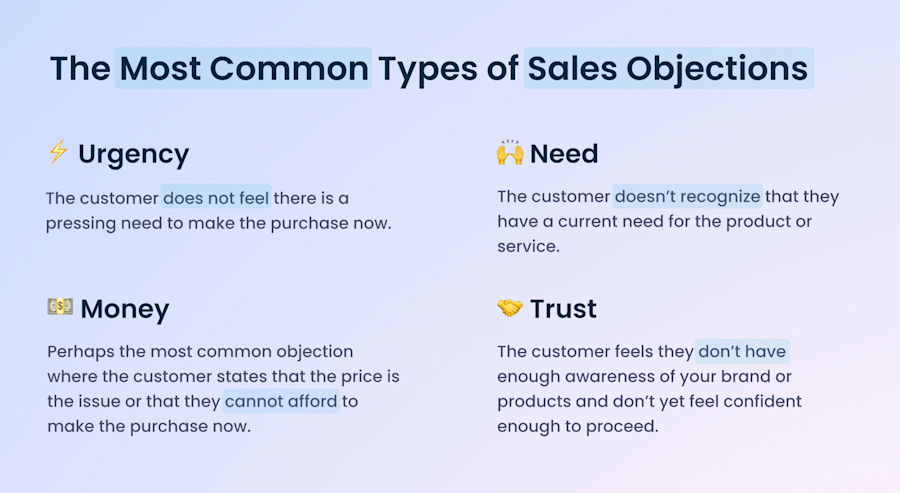If you’re a salesperson, there may be no worse feeling than losing a sale, especially if you think you’ve given it your all.
There may be lots of reasons why a customer decides not to purchase and, spoiler alert, it’s not always possible to overcome those reasons.
The sales process can differ greatly; from physical stores to reps on the road to sales calls. Whatever the form of the sales process, a sales rejection can be hard to take but you should look at it as a learning opportunity. How can you better handle sales objections in the future? Can you go back to the customer with better answers and get that sale? Can tools such as contract management software help in any way?
Knowing how to overcome sales objections is an essential skill for anyone working in sales. You may not have an answer to every question or objection, but you should be able to anticipate most of them. They should also be able to utilize automation for sales and marketing purposes through tactics such as targeted and retargeted marketing or personalized emails.
We look at how salespeople can handle objections when faced with them and how best to move forward.
What is a sales objection and what are the most common types?
At its most basic level, a sales objection is a point or question raised by a potential customer that prevents you from closing a sale. It’s a signal that no matter how much effort you have made so far, there is still work to be done to make that potential customer an actual customer. Your sales team could probably list multiple objections they have experienced but these tend to be the most common ones.

While any sales professional will have experienced these objections, there is one common thread running through them all; none of them are an outright rejection of the concept of buying. That means you face one of two possible scenarios and have no time to wallow in self-doubt. You can either look to overcome the objections there and then or you can follow up the sales conversation later.
10 tips on how to handle sales objections
1. Stay calm
Okay, you may have put a lot of time and effort into your sales pitch so it is understandably frustrating when you meet an objection. But there’s no point in openly displaying that disappointment. Stay calm and discuss the objections that the customer presented. Showing offense or frustration is unprofessional and will more than likely put the customer off of your brand for life.
If there really is no way forward, then thank them for their time. Remember, they may be saying no right now but they’re still a potential client in the future. Another best practice is to take their contact details so that you can, with their permission, put them on your subscriber list and send them marketing emails or product/price updates.
2. Investigate
Quite often, you may experience a customer saying no without any explanation. If you don’t know their reasons for not buying, how can you overcome their objections now or in the future? Using the ‘stay calm’ rule as your starting point, try and discover why they don’t want to make a decision. Use open-ended questions to gather more information about their reasoning.
By investigating those reasons and using reflective listening, you may not only have an opportunity to overcome those objections, but you may also learn something that you can use in future sales pitches and conversations. And, if you haven’t already, this can be a good stage to take contact info. For example, if their objection just now is the pricing point, you could email or call them if there is a discount on that product.
3. Don't be consumed by self-doubt

Image sourced from statista.com
It can be all too easy to look at yourself for failings when a customer says “no” or raises objections. The reality is that you will hear “no” more than “yes”. In the fourth quarter of 2021, the average conversion rate of online shoppers was 2.6 percent, and that’s at a time of year when conversion rates are normally at their highest. So, in most scenarios, it really isn’t your fault, and may just be the case that now is not the time when a client’s need means a successful sale.
As well as remaining calm in the face of rejection, it’s also crucial to avoid that confidence-denting self-doubt. Listen to the reasons why the customer does not want to commit. If you’re unable to overcome their objections, take their feedback on board. Remember, there may be many positive points to your pitch to boost your confidence.
4. Focus on your strengths and identify your weaknesses
There’s a strong argument that sales is an art form in itself. Do you think that any of the great artists went straight to producing masterpieces? Even experienced salespeople can reflect on unsuccessful pitches and analyze their performance and this is something you should emulate. If a pitch or sales conversation does not result in a sale, reflect on your performance and identify strengths and weaknesses.
And, just as with the great masters, don’t be afraid to practice your sales pitches. These rehearsals can be solo (just talk to a mirror so you can see your body language too) or roleplay with colleagues. People may have different strengths and weaknesses and work together can help build a cohesive and confident sales strategy.
5. Analyze your general approach
One of the advantages of the last tip, particularly when working with colleagues, is that you can analyze your approach as a whole. Perhaps you are highlighting the wrong things or spending too much time on particular points. If you’ve been experiencing poor conversion rates, then this can lead to fear of rejection and low confidence. In that case, it may be time to totally revise your approach.
There can be many aspects to a sales pitch that may lie at the heart of a refusal. Perhaps your pitch is too short, so the customer feels that there hasn’t been time to build trust. Or a pitch may be too long, meaning that a decision-maker may simply lose interest. Or maybe you aren’t giving enough product/service information and spending too much time on info that may be irrelevant to your potential new client.
6. Check your knowledge base
It doesn't matter whether your sales conversations are in-person, on social media, or via cold calls. When you’re talking to business owners or decision makers, they want comprehensive information on your product or service. If you’re doing B2B sales, you need to remember that these people may not have a lot of time to listen to pitches and that they will generally have good industry knowledge, so you need to show that you are an expert.
You shouldn’t only know your product or service inside-out, you should also know how it compares against your closest competitors, both in terms of performance and pricing. If a potential customer raises a question about a cheaper competitor, have the knowledge to explain why you are more expensive. Use testimonials to demonstrate customer satisfaction and accentuate the positives of what you’re offering.
7. Anticipate
As you gain experience, you will recognize that there are common objections, some of which were mentioned earlier. By anticipating what objections may be raised, you can preempt them making those objections by including any answers in your initial pitch. For example, if you’re regularly encountering an objection that your product is more expensive than a competitor, you can include that fact in your pitch and explain why, highlighting the unique features.
While some objections may be obvious and you can learn about them in other sales training, others you can only learn over time. Highly experienced sales professionals can anticipate almost all objections they will face and can either address them in their original pitch or have answers ready if the customer raises them during or after the pitch. They also know that the quality of lead generation can vary greatly from sector to sector and will approach any sales conversation with that in mind.
8. Don’t give up
As has been mentioned, just because a potential client says no to your first pitch, it doesn’t mean that they won’t buy your product later. Be prepared to move forward and consider outreach after an appropriate period of time.
Taking their contact details is an essential part of this. If you’re in the B2B sales and marketing world, you can connect with them via LinkedIn to present a new offer in the future. Having their details entered into your CRM means you can identify when a lead becomes warm again and you have an accurate record of previous interactions so you can move forward.
9. The customer is always right
Just as important as remaining calm in the face of initial rejection is to not argue with or contradict your customer. This can often come down to a careful choice of words when dealing with objections. For example, using ‘but’ can come across as confrontational. It’s far better to empathize with any problem they have (such as a lack of budget).
Showing empathy and understanding with any objection they have puts you in a better position to deal with it, either now or later. It all comes down to building trust and understanding that a rejection is not always a lost opportunity, it may just be a delayed one. In many cases, you are looking to build a long-term relationship with the customer so be careful of word choices.
10. When it’s wrong, it’s wrong
While we encourage you not to give up and to always follow up, you also have to accept that there will be occasions when there is no point in follow-ups. Sometimes you just have to accept that a prospect and your product/service are simply not a good fit. That doesn’t reflect on your abilities — they just don’t fit your ICP.
Even what seems to be the best referral can sometimes lead to a dead end with no chance of a sale. The two things to remember are that this does not mean you are a failure and that the prospect may become a warm lead in the future when circumstances have changed.
The takeaway
If anyone ever tells you that sales is easy, you can laugh in their face. Depending on the industry you work in, selling a product will always come with varying degrees of difficulty.
An efficient sales team will also have tools and technology to help with their jobs. They may use a platform such as Hubspot to help with sales and marketing, and they will use easily accessible templates for building quotes for potential customers or even the best electronic signature software. Losing a sale does not make you a bad salesperson but understanding why you lost it can make you a better one.
You should also make decisions and develop tactics based on data and other evidence. This can be especially true when you are involved in online sales. Using good web analytics tools can help you make informed decisions that can make a real difference to performance and results.
Now that you're here
Leadfeeder is a tool that shows you companies that visit your website. Leadfeeder generates new leads, offers insight on your customers and can help you increase your marketing ROI.
If you liked this blog post, you'll probably love Leadfeeder, too.
Sign up







